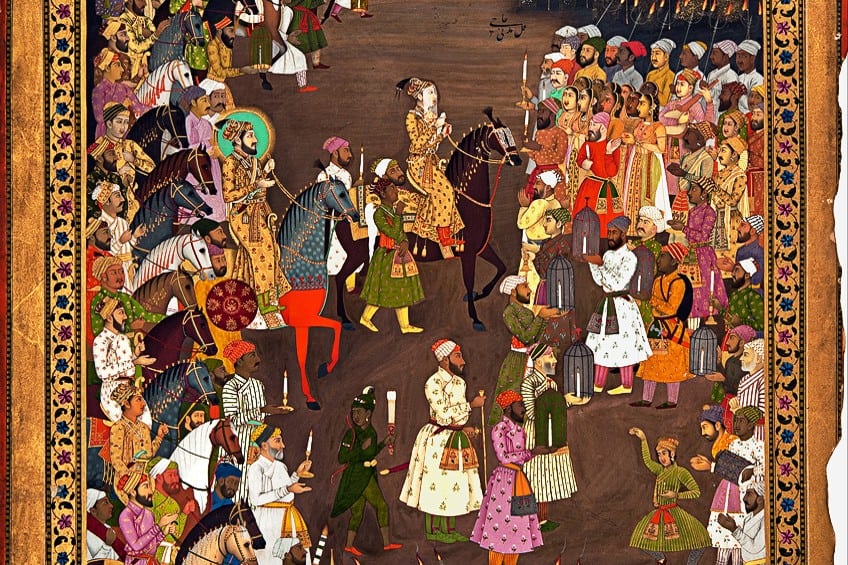Islamic Art – Discover Important Islamic Art and Architecture
What is Islam art or Muslim art? Islamic art and architecture is a component of Islamic culture that includes the visual arts created by individuals who lived in regions occupied or dominated by Muslim communities since the 7th century AD. Muslim art or Islam art is a Western concept that originated in the 19th century and when referring to Islamic art characteristics, Westerners are actually talking about a range of traditions from various genres, people, and periods. The most common forms are Islam calligraphy art, Islamic paintings, carpets, ceramics, glass, metalwork, and Islamic drawings.
Contents
Islamic Art and Architecture
The absence of people in the more religious Islamic art has led instead to the prominent use of calligraphic, geometrical, and abstracted floral Islamic motifs by Muslim artists. Representations of animal and human forms have traditionally flourished in practically all Islamic countries’ secular artwork, yet, partially due to competing religious beliefs, live people in Islamic paintings were typically stylized, giving rise to a range of beautiful figural Islamic motifs.
From the woodwork to the architecture and rugs, both secular and religious, Islam art items frequently reflect the same styles, references, and patterns.
Types of Islamic Art
Textiles, such as rugs, garments, or tents, as well as domestic goods made of wood, metal, or other materials, are examples of secular arts and crafts. Furthermore, figurative miniature Islamic paintings have a long history, particularly in Mughal, Persian, and Ottoman art. These images were frequently intended to depict well-known historical or literary stories. Some versions of Islam, however, prohibit the representation of live beings, a practice known as aniconism.
The ban on idolatry, as well as the notion that the conception of life forms is God’s authority, contribute to Islamic aniconism.
Islam Calligraphy Art
Calligraphy is ubiquitous in Islamic art, where, just as in Europe throughout the Middle Ages, religious pronouncements, including verses of the Qur’an, would often be incorporated into secular items, particularly tiles, coins, and metals. Most painted miniatures, as well as many structures, also incorporate Islam calligraphy art.
Traditional Arabic calligraphy and manuscript ornamentation for written copies of the Qur’an reflect a key legacy of Islamic visual art.
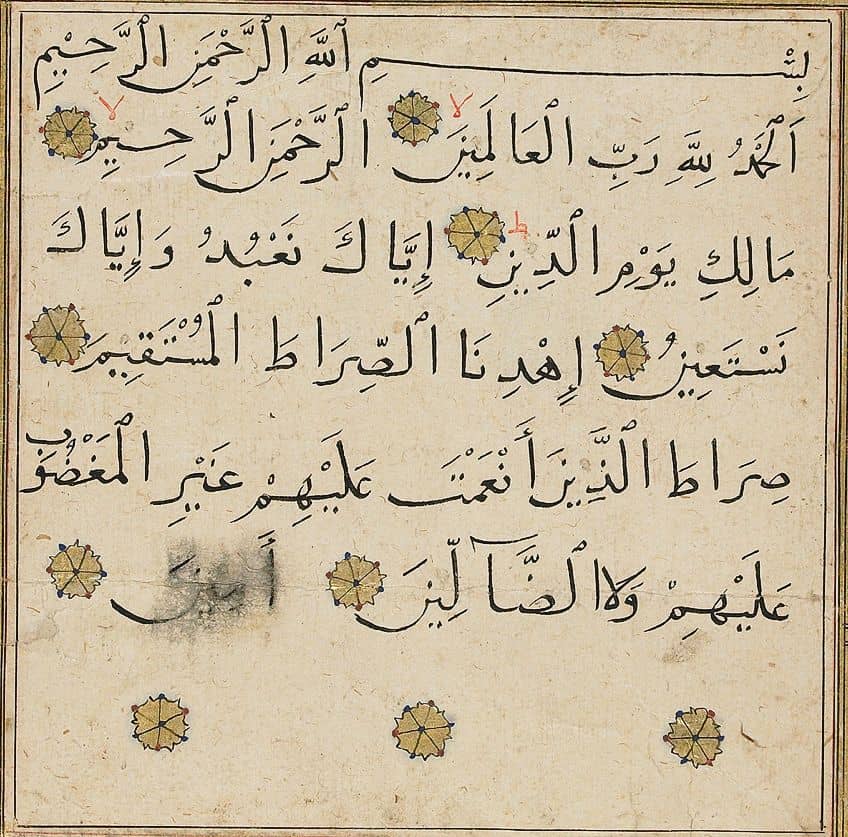
The arabesque is frequently used to represent God’s transcendental, infinite, and boundless essence. Errors in repetitions may be included on purpose as a sign of humility by Muslim artists who feel that only God can achieve flawlessness, however, this view has also been challenged. On the exteriors and interiors of many significant structures, large lettering made of tiles, occasionally with the letters elevated in relief or the background scraped away, may be observed. For the duration of the Islamic period, the majority of coins solely displayed calligraphy, which, despite their tiny size and manner of manufacturing, was quite often extremely exquisite.
Islamic calligraphers were often held in greater regard than other artists.
Islamic Paintings
While it is not forbidden in the Quran, producing pictures of humans and creatures is disapproved of in many Islamic societies and is linked to rules against idolatry that apply to all Abrahamic religions. Nonetheless, various historians have interpreted this rule differently, and there are instances of Islamic paintings depicting both animals and people in Persian, Mughal, and Turkish art. Siyah Qalam commonly shows demons from Islamic legends, yet they appear to originate from Central Asia.
This reluctance to depict people has been suggested to explain the prominence of tessellation, calligraphy, and pattern as important features of Islamic artistic tradition.

Although wall paintings have a long legacy, particularly in the Persian world, the miniature in illuminated manuscripts is the best-surviving and most evolved type of painting in the world of Islam. Miniatures were particularly a court art, and because they were rarely viewed in public, it has been suggested that limits on depicting the human form were considerably more lenient, and miniatures frequently feature a large number of figures.
Portraits of rulers emerged in the 16th century and thereafter in Persia, where they quickly became famous.
Mughal portraits, which are usually in profile, are very precisely done realistically, but the greatest Ottoman portraits are passionately stylized. Picnic settings, portraits of people or animals, or idealized young people of either sex were common subjects for album miniatures.
Islamic Carpets
The Oriental rug is the most well-known Islamic creative product outside of the Islamic world. Known in Islam as pile rugs, they are used in daily Islamic life, from floor coverings to architectural embellishments, pillows to bags of various sizes and shapes, and religious items. They have been a significant export to other places since the late Middle Ages, used to cover not only floors but also tables, a habit that was once ubiquitous in Europe but is now only seen in the Netherlands.
Carpet making is a rich and profoundly ingrained tradition in Islamic countries, and it may be found in both huge metropolitan factories and rural settlements and nomadic encampments.

Previously, some specific businesses and workshops operated directly under royal patronage. Early Islamic carpets are incredibly difficult to find. Many have survived in the West, and oriental rugs in Renaissance artwork from Europe are a significant source of knowledge about them, as they were important imports that were correctly portrayed. Straight lines and edges are the most natural patterns for a carpet weaver to create, and the earliest Islamic carpets to remain or be shown in art contain geometric motifs or center on extremely stylized figures created in this manner.
Because the arabesque’s flowing curves and loops are important to Islam art, the interplay and tensions between these two forms have long been a characteristic of carpet design.
Architecture
The architecture of early Islamic columns was influenced by the classic era of the Mediterranean. Traditional columns can be seen in previous mosques such as Damascus’ Great Mosque. The shape of these columns might range from entirely smooth to having twisting or vertical fluting. Islamic arches, like columns, followed a Roman architectural style.
During the 8th and 10th centuries, archways were increasingly important in Islamic architecture. Islamic arches come in three different shapes, namely keel, horseshoe, and polylobuled.
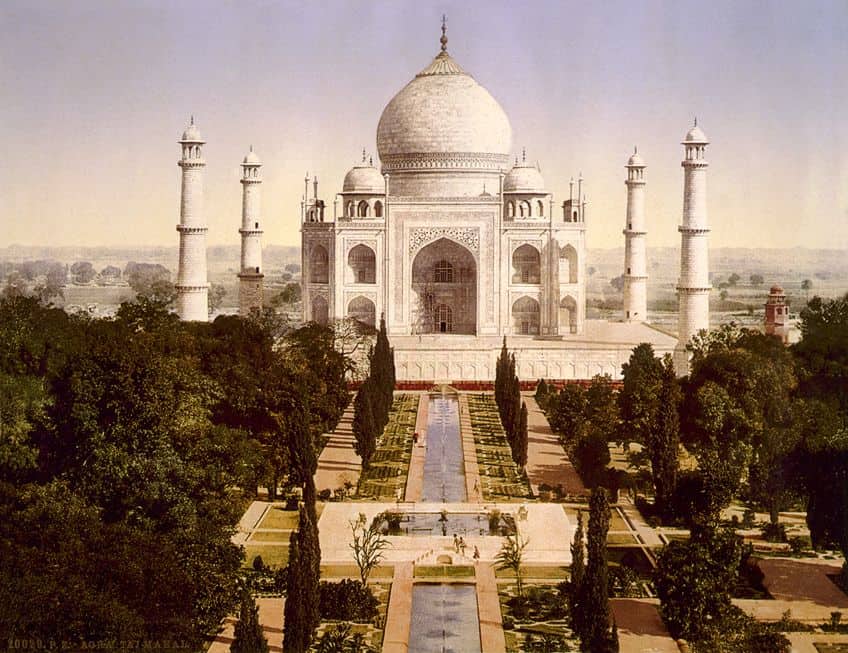
Islamic Ceramic Art
Islamic art has made noteworthy advances in ceramics, both in pottery and wall tiles, which were brought to unrivaled heights in the dearth of wall paintings. Although early pottery is frequently unglazed, the tin-opacified coating was one of the first new methods invented by Islamic potters. The very first Islamic opaque glazes were discovered as blue-painted porcelain in Basra during the 8th century. Another notable contribution came from the 9th-century Iraqi creation of stone-paste pottery.
In the eighth century, Syria constructed the first industrial facility for pottery and glass manufacture. Fustat, Damascus, and Tabriz were other important locations for creative pottery in the Islamic world.
Lusterwares with iridescent colors may have maintained pre-Islamic Roman and Byzantine traditions, but from the 9th century on, they were significantly refined on ceramics and glass in Syria and Persia. Chinese ceramicists, whose successes were much appreciated and mimicked, frequently influenced Islamic pottery. This was especially true in the aftermath of the Timurid and Mongol invasions. Techniques, forms, and ornamental themes have all been influenced.

Until the Early Modern period, Western ceramics had limited impact, while Islamic pottery was much sought after and frequently reproduced in Europe. In the 16th century, Turkish Iznik pottery created the majority of the best work, in tiles and big vessels boldly adorned with floral designs influenced by Chinese Ming and Yuan ceramics. These were still clay; until recent times, no porcelain was created in Islamic nations, though Chinese porcelain was acquired and adored.
Pottery with painted human and animal motifs was also common in medieval Islamic culture. Examples may be found all across the medieval Islamic world, but especially in Egypt and Persia.
Islamic Tiling
The interior walls of the oldest magnificent Islamic buildings, such as Jerusalem’s Dome of the Rock, were covered with mosaics in the Byzantine tradition, but without figures. The characteristic Islamic tradition of glazed and vividly colored tiling for internal and external walls and domes emerged beginning in the 9th century. Some early schemes employ a combination of tiles, each of a single color, that are either cut to form or are tiny and of a few shapes, to produce abstract geometric patterns.
Later, big painted schemes employed tiles painted with a segment of the design before firing – a technique that requires trust in the consistent outcomes of firing.
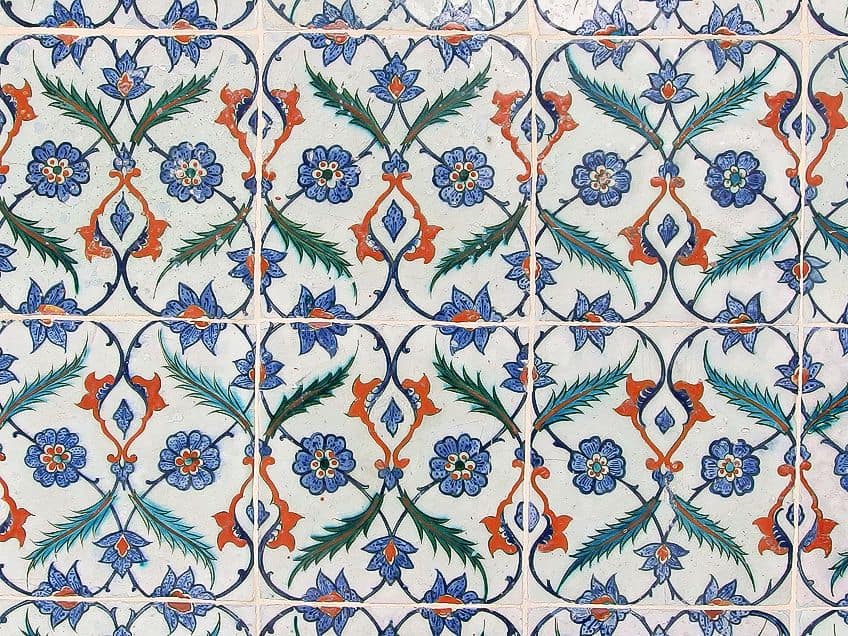
Some parts, particularly inscription lettering, may be sculpted in three-dimensional relief, and select tiles in a pattern, particularly in Persia, may feature figurative paintings of creatures or solitary human figures. These were frequently used in patterns that were primarily made up of simple colored tiles with bigger completely painted tiles interspersed. Larger tiles are frequently formed as eight-pointed stars and may depict animals, a human head or bust, plants, or other Islamic motifs.
Geometric patterns, such as current North African zellige art, are sometimes referred to as “mosaic,” despite the fact that it is not entirely accurate.
Islamic Glass
For the majority of the Middle Ages, Islamic glass was the most advanced in Eurasia, with exports to both China and Europe. Because figurative ornamentation played a minor role in pre-Islamic glass, the transition in style is not rapid, except that the entire area first constituted a geopolitical whole, and, for instance, Persian advances were now almost instantly adopted in Egypt.
As a result, it is sometimes hard to identify between the many centers of production, the most significant of which were Syria, Egypt, and Persia, unless by scientific investigation of the material, which is challenging in and of itself.
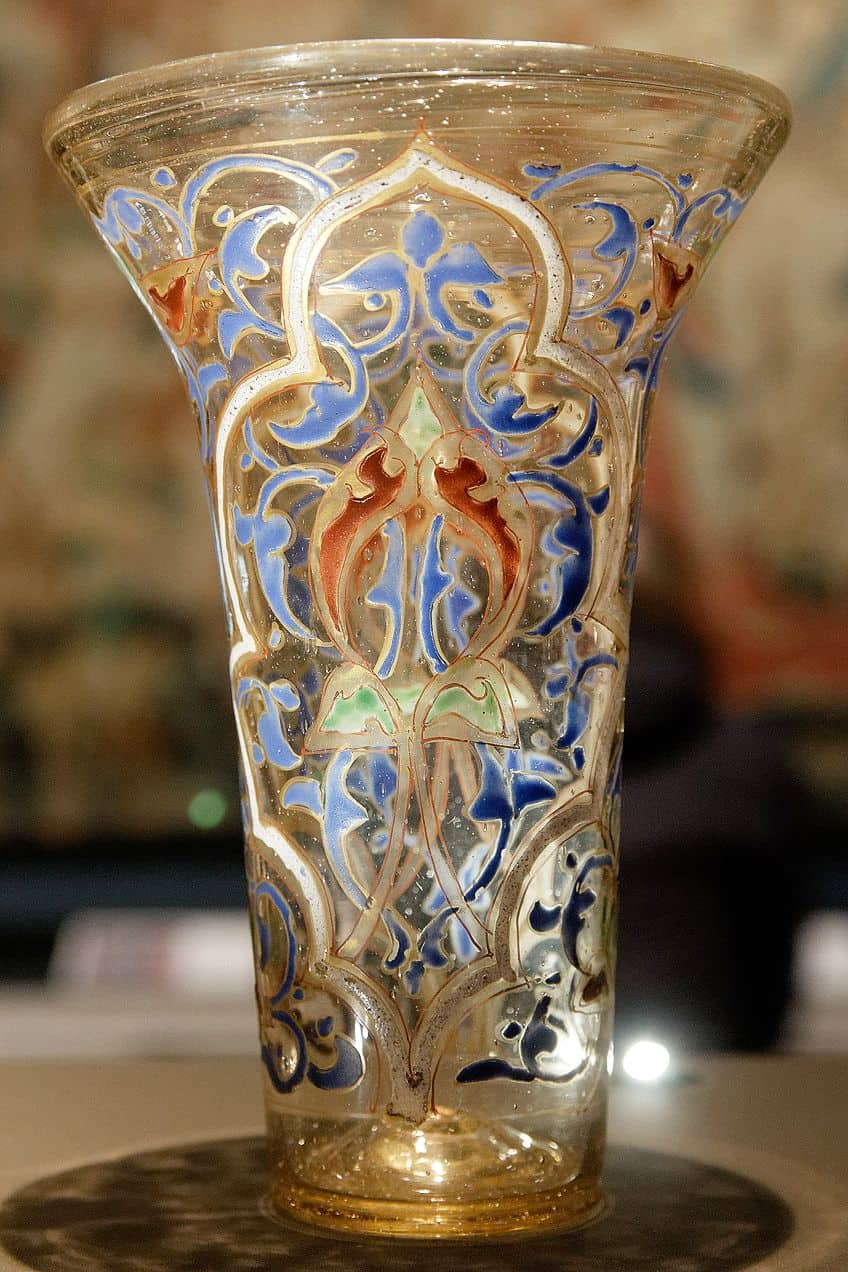
Luster painting, which uses methods similar to lustreware in ceramics, dates back to the eighth century in Egypt and became popular in the 12th. Another method was embellishment with different colored glass threads incorporated into the main surface and occasionally controlled by combing and other techniques.
Metalwork
Medieval Islamic metalwork stands in stark contrast to its European counterpart, which is characterized by sculpted figures and vividly colored enamel embellishment, with some items completely in precious metals. Enduring Islamic metalwork, on the other hand, consists of practical objects mostly made of bronze, brass, and steel, with simple but often extraordinary forms and surfaces richly adorned with complex decoration in a wide range of techniques, but the color is mostly limited to inlays of silver, gold, copper, or black niello.
The most common medieval relics are delicate brass artifacts that are beautiful enough to save but not precious enough to burn down.
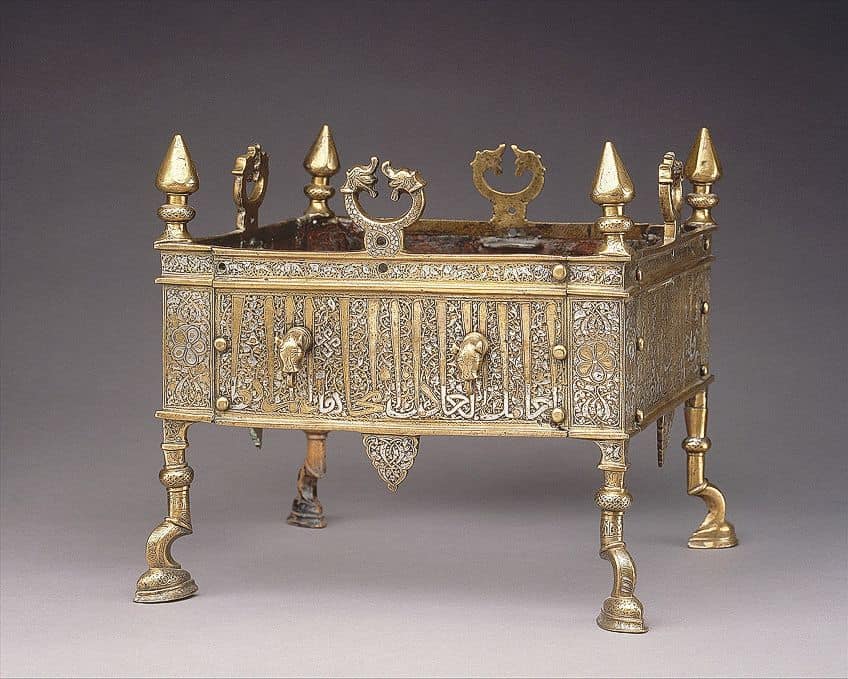
The abundance of zinc locally, as opposed to tin, explains the scarcity of bronze. Household objects like ewers and water pitchers were manufactured from one or more sheets of brass that were welded together and then worked and engraved. The Hadiths forbade the use of silver and gold eating and drinking cups, which were ideal in Persia and Rome, as well as medieval Christian communities.
When compared to other artists and craftspeople, Muslim metalworkers enjoyed an elevated social position with their European equivalents, and many bigger items are signed.
History of Islamic Art and Architecture
When people talk about Islamic art characteristics, they are referring to a very broad style that encompasses many regions and periods. However, when trying to discern where the beginning point is, most historians agree that the Pre-dynastic period is arguably the most likely choice.
The earliest examples of Islamic drawings may be hard to differentiate from the Byzantine, Sasanian, and Persian art that preceded it, and it took centuries for the population at large – including artists – to convert to Islam as it spread across the globe.
During the very early period of Islam art, significant quantities of unglazed ceramics were produced, and they were commonly adorned with plant motifs. The Byzantine-style coins which typically featured human figures were succeeded by the Islamic style where Islamic calligraphy became the standard.
The Umayyad
Under the Umayyad Caliphate, new concepts and plans regarding civic and religious architecture were put into practice. During this period, one of Islam’s most important structures was built: The Dome of the Rock. The structure featured a strong influence from Byzantine architecture, as well as elements of Christian structures such as the Church of the Holy Sepulchre, yet it also featured distinctively Islamic motifs and architectural elements.
To promote an appearance of royal opulence and wealth, many of the reception halls, living quarters, and baths of the desert palaces in Syria and Jordan were decorated, including frescoes.
During this period the art of ceramic manufacture was still relatively undeveloped, and objects were still unglazed. There have been a few examples of metalwork unearthed from this period, but they are indistinguishable from those produced in the -pre-Islamic period. This period saw the emergence of Islamic art characteristics in everything from architecture to coinage.

However, Muslim art had not yet fully developed into its own. Many Muslim artists were still heavily influenced by the styles of Iranian and Mediterranean antiquity, yet recontextualized many concepts – adapting them to suit their narratives and concepts. This can be seen in structures such as the Umayyad Mosque which can be found in Damascus. In the mosque, one can observe mosaics that have been influenced by the Byzantine tradition, yet the figures have been replaced with cityscapes and trees.
Through this combination of influences over time, a new style of Islamic art started to arise incrementally, gradually finding its own visual language and aesthetic.
The Abbasid
During the era of the Abbasid Caliphate, the capital moved from Damascus to Baghdad, and eventually on to Samarra. The relocation to Baghdad signified a huge change in culture, art, and politics, and some historians liken the capital to the equivalent of an Islamic Rome, as Islamic art experienced a paradigm shift due to the blending of various Eastern influences ranging from Chinese, Iranian, and Eurasian sources.
The Byzantine influences began to fade in favor of these new Islamic motifs and styles.
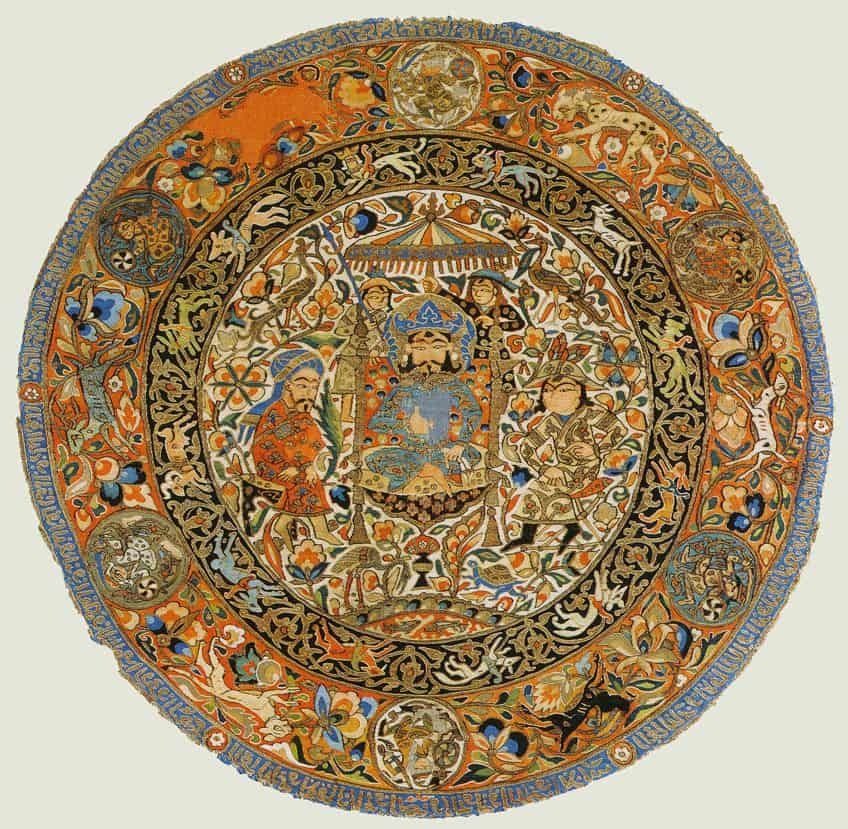
Ceramics experienced a huge advance in development and most regard Islamic pottery as the greatest focus of production during this period. However, it was textiles that experienced the greatest advances during this time, and much of this had to do with the production of silk.
Islamic art calligraphy also started to become a common feature found on pottery at this time.
The Medieval Period
Al-Andalus was a significant Middle-Eastern cultural hub. Aside from the reputed institutions that taught sciences and ideologies previously unknown in Christendom, the region was also an important center for art. Several methods were used in the creation of objects. Ivory was widely employed in the production of caskets and boxes. Large metalwork sculptures, which were generally uncommon in the Islamic culture, were used as exquisite fountains.
Many textiles, most significantly silks, were exported; many may be seen in Christendom’s church treasuries, where they functioned as coverings for saints’ relics.
In the 10th century, Iran and northern India contended for dominance, and art was an important part of that conflict. The funerary architecture was also established, and potters produced distinct styles such as kaleidoscopic ornamentation on a yellow foundation, marbled designs formed by allowing colorful glazes to flow, and painting with numerous coatings of slip under the glazing. A booming economy and increasing urban affluence increased popular patronage. Inscriptions in architecture typically concentrated on the piece’s sponsors. Sultans, princes, and lower-ranking dignitaries, for instance, would frequently be mentioned in calligraphy on mosques.
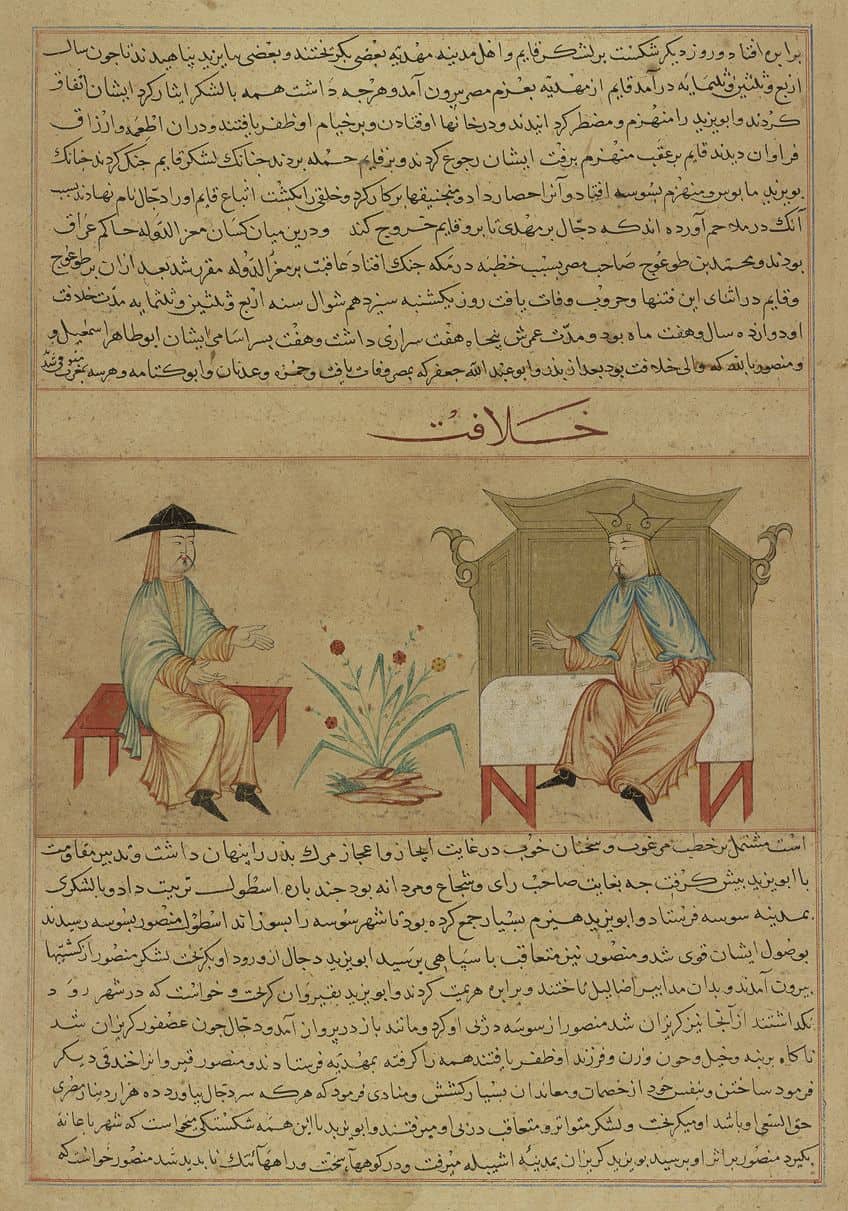
Meanwhile, the expansion of mass-market production and the selling of art made it more widespread and attainable to merchants and dealers. Because of improving efficiency and productivity, numerous relics from the Seljuk period have been preserved and can be dated, whereas the age of older works is more uncertain. The Ilkhanids, who were initially subordinate to the Yuan monarch but quickly became sovereign, established a prosperous civilization.
As the Mongols became more settled, architectural activity increased while retaining elements of their nomadic roots, such as the north-south alignment of their houses.
The earliest artworks of the Golden Horde nomads are poorly studied as research has only recently started, and indications of town planning and building have been uncovered. There was also a substantial number of gold pieces, many of which had a distinct Chinese influence. Much of this art is now housed in the Hermitage. The Turkmen were nomadic tribesmen who dwelt around Lake Van. They constructed several notable mosques, including the Blue Mosque, and they exerted significant power following the collapse of the Anatolian Seljuqs.
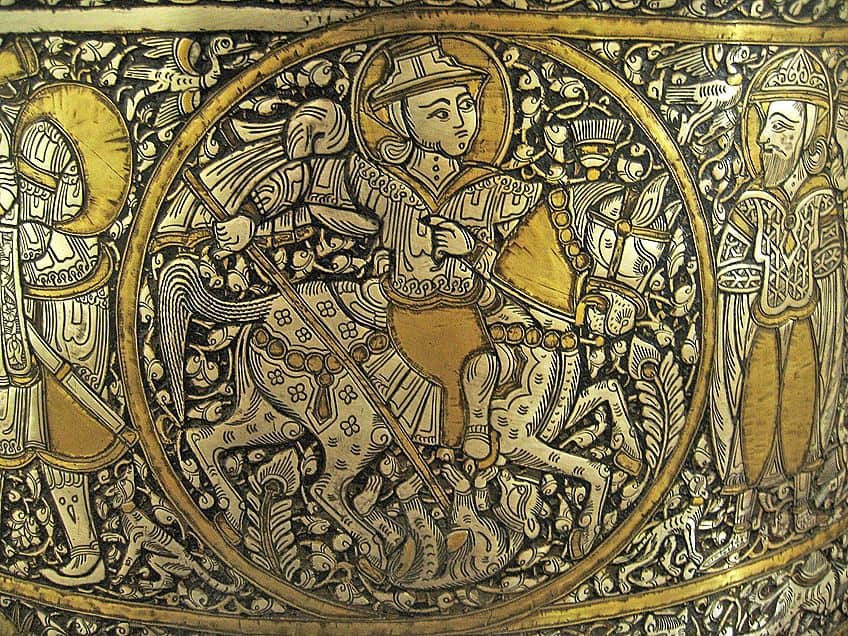
From the 13th century, Anatolia was governed by local Turkmen rulers that steadily eroded Byzantine territory. Turkmen artworks, particularly “Milet” pottery and the first white-and-blue Anatolian pieces, could be considered forerunners of Ottoman art.
The Indian subcontinent, which was conquered by the Ghurids and the Ghaznavids in the 9th century, did not gain independence until 1206.
Later, rival sultanates were established, and they gradually detached themselves from Persian traditions, giving rise to a distinctive approach to architecture and urbanization that was defined, in particular, by engagement with Hindu art. The study of object manufacturing has just recently begun, yet a vibrant art of text illumination is documented.
The Three Empires
The Ottoman Empire, which dates back to the 14th century, lasted until just after World War I. This remarkable staying power, combined with a vast territory, naturally resulted in an important and unique art, which included mass production of ceramics, abundant architecture, notable metalwork and jewelry, Turkish, and exemplary Ottoman miniatures.
The Ottomans are also notable for developing a vivid red color, “Iznik red,” in ceramics, which reached its peak in the 16th century, both in tiling and pottery, employing floral designs that were significantly modified from their Persian and Chinese predecessors.
The Mughal Empire ruled the Indian subcontinent until 1858, although actual control only shifted away from the monarchs in the late 17th century. The era is most known for its courtly arts, and Mughal traditions impacted both native Hindu and later Sikh monarchs. The Mughal miniature tradition originated with the importation of Persian artists, but local artists, many of whom were Hindu, were quickly instructed in the technique. Mughal art expanded realistic portraits and pictures of animals and vegetation beyond what the Persians had previously accomplished, and the size of miniatures expanded, occasionally onto canvas.

The Iranian Safavids, an empire that ruled from 1501 to 1786, were distinguishable from the Ottoman and Mughal Empires in part due to their shahs’ Shi’a faith. Chinese porcelain, generally produced in white and blue, had a significant impact on ceramic arts. Manuscript illumination also reached new heights, most notably in the Shah Tahmasp Shahnameh, a massive copy of Ferdowsi’s poetry with over 250 Islamic paintings. A new form of painting developed in the 17th century centered on the muraqqa album.
Connoisseurs created the books by binding together single sheets of Islamic drawings, paintings, or calligraphy by numerous artists.
Famous Muslim Artists and Architects
Now that we have had a look at the various types of Islamic artwork that are commonly produced, we can explore a few notable Muslim artists and architects. Islam art is not limited to a specific region or timeframe, and Islam is practiced throughout the world. Therefore, we can find examples of Muslim artists from many continents and periods.
Mimar Sinan (1490 – 1588)
| Nationality | Turkish |
| Date of Birth | c. 1490 |
| Date of Death | 17 July 1588 |
| Place of Birth | Ağırnas, Turkey |
Mimar Sinan is often regarded as one of the most influential architects of all time. At 22 years of age, he was recruited into the Ottoman military, and traveled across the empire, including places such as Egypt, Damascus, Baghdad, and Persia. In these places, he observed and absorbed the architectural styles still visible in the remains of the ancient ruins of antiquity.
By the time he was around 50 years of age, he had acquired a reputation as a highly-respected architect and was appointed the head royal architect in 1537 by Sultan Suleyman.
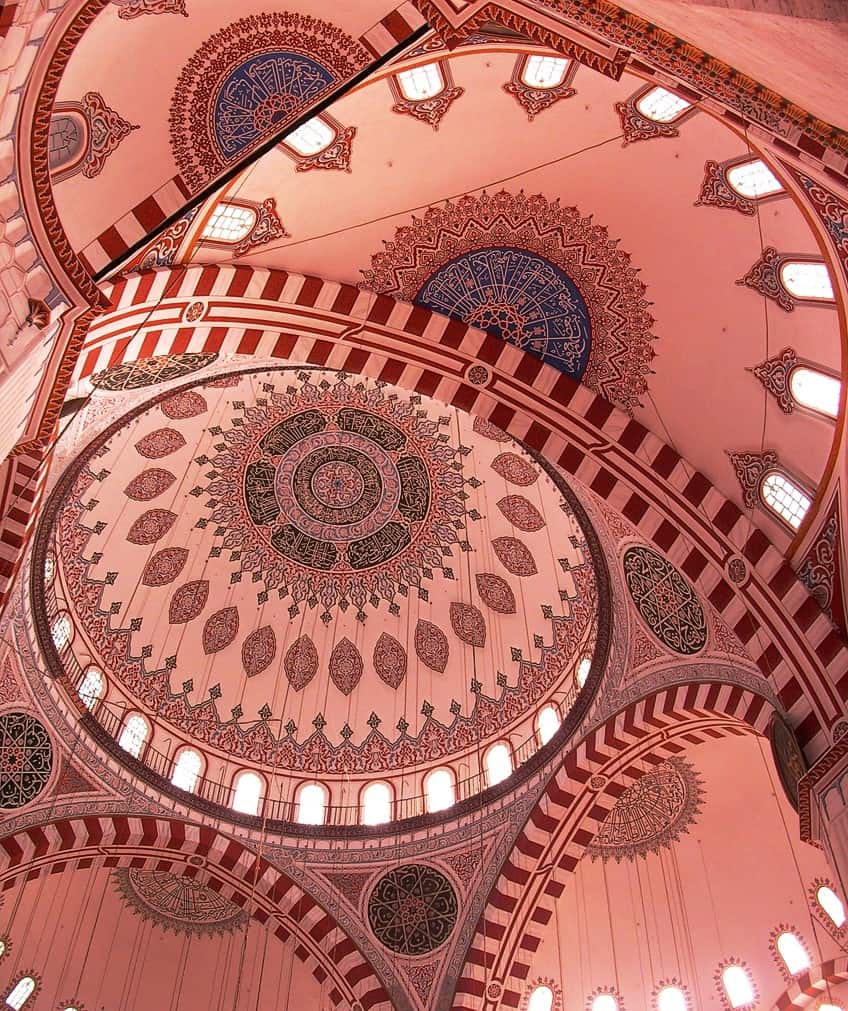
When Prince Mehmet, one of the sultan’s sons, died, Sinan was ordered to build a royal mosque in his honor. And so, he designed and constructed the Sehzade Mosque, which many consider to be his greatest achievement, as well as one of the most iconic structures known today. During his time as the architectural head, he supervised the construction of many buildings due to a sudden influx of both private and royal clients.
This led to a change in the landscape of Istanbul and positioned it as one of the most beautiful cities in the world.
Hédi Khayachi (1882 – 1948)
| Nationality | Tunisian |
| Date of Birth | 1882 |
| Date of Death | 1948 |
| Place of Birth | Tunis, Tunisia |
Hédi Khayachi came from a particularly auspicious lineage, and he was said to have descended from the prophet Mohammad. At the beginning of the 19th century, the Khayachi clan settled in Monastir to supply goods to civil servants in the area, and his father started his artisan workshop in Tunis. He enjoyed painting from a young age and attended several of Montparnasse’s free institutions.
He then went on to study in Rome, where he learned portraiture and had the opportunity to visit the famous museums in Europe.
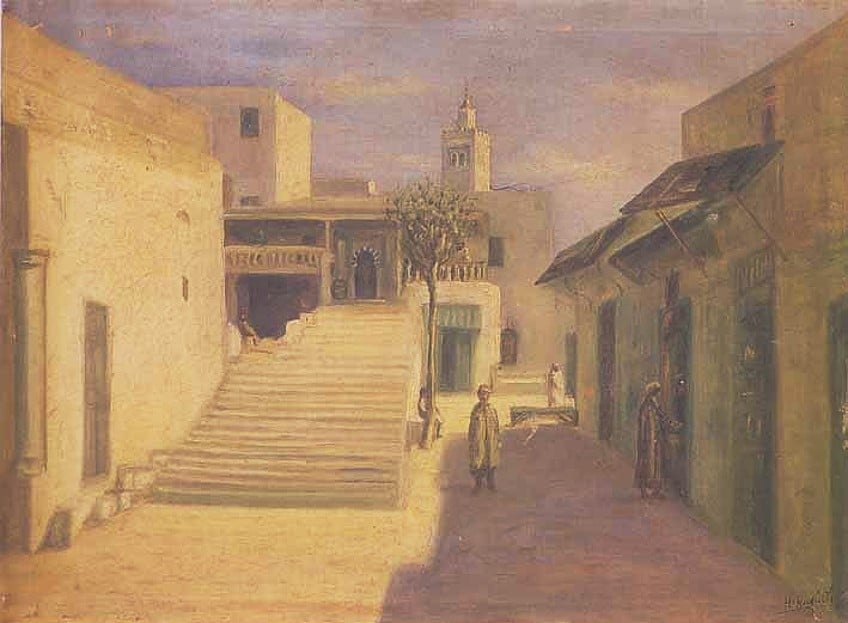
He then started to produce the official portraits of the monarchs of Tunisia in 1908, leading to him being regarded as Tunisia’s most renowned portrait artist. Although he is mostly known for his portraiture, he also produced scenery of traditional Tunisian life and landscapes. He portrayed Tunisian women in various styles and was known for his mastery of the interaction of shadow and light.
Khayachi was regarded as one of the Tunisian artistic pioneers, along with Yahia Turki, Pierre Boucherle, Moses Lévy, Ali Bellagha, Ammar Farhat, and Jules Lellouche.
Syed Sadequain Ahmed Naqvi (1930 – 1987)
| Nationality | Pakistani |
| Date of Birth | 30 June 1930 |
| Date of Death | 10 February 1987 |
| Place of Birth | Uttar Pradesh, India |
Syed Sadequain Ahmed Naqvi was a renowned painter and calligrapher from Pakistan and is regarded as one of the country’s finest artists. Many South Asian art critics consider his calligraphic style to be iconic. He was a representative of a broader Islamic art movement, known as the Hurufiyya movement that arose in parts of Asia and North Africa in the 1950s. This movement strove to combine contemporary artworks with traditional calligraphy and other traditional mediums. They rejected Western motifs and ideas in search of a visual language that told the story of their heritage and culture.
Artists such as Sadequain thus managed to transform calligraphy into a form that was both indigenous and contemporary, with a distinctly modern aesthetic.

He is regarded as a pioneer in Pakistani calligraphy and influenced many subsequent artists from the region. Most of his works were murals for public spaces and were donated by the artist himself, as he did not want to adorn the living spaces of the powerful and wealthy. He was a social commentator and his figures carried allegorical significance.
Islamic art and architecture have indeed had a long history. They encompass many regions and eras and have seen many shifts in tone and style over the centuries. So what truly unifies Islam art under a single umbrella? Islamic art is also known as Muslim art because that is the prominent religion found in most countries where this style is most prominent. Although not all works from these areas are religion-based – a large portion was, and for many years much of the literature, art, and architecture, were strongly influenced by the Islamic faith.
Frequently Asked Questions
What Is Islamic Art?
Islamic art is the art created by the followers of Islam, which is one of the three Abrahamic faiths. The style is not confined to a single time or place, as Islam is practiced across the world. Islam art as we recognize it is mostly known for the incredible mosques, carpets, calligraphy, and jewelry.
What Are the Islamic Art Characteristics?
Islamic art can be hard to define as it encompasses such a large period. A common distinguishing feature of Islamic drawings is that they usually don’t portray people due to religious beliefs that only god should create figures. Instead, they have created artworks that are based on patterns and intricate floral designs. Islam calligraphy art is also a highly regarded art form.
Jordan Anthony is a Cape Town-based film photographer, curator, and arts writer. She holds a Bachelor of Art in Fine Arts from the University of the Witwatersrand, Johannesburg, where she explored themes like healing, identity, dreams, and intuitive creation in her Contemporary art practice. Jordan has collaborated with various local art institutions, including the KZNSA Gallery in Durban, the Turbine Art Fair, and the Wits Art Museum. Her photography focuses on abstract color manipulations, portraiture, candid shots, and urban landscapes. She’s intrigued by philosophy, memory, and esotericism, drawing inspiration from Surrealism, Fluxus, and ancient civilizations, as well as childhood influences and found objects. Jordan is working for artfilemagazine since 2022 and writes blog posts about art history and photography.
Learn more about Jordan Anthony and about us.
Cite this Article
Jordan, Anthony, “Islamic Art – Discover Important Islamic Art and Architecture.” artfilemagazine – Your Online Art Source. October 3, 2022. URL: https://artfilemagazine.com/islamic-art/
Anthony, J. (2022, 3 October). Islamic Art – Discover Important Islamic Art and Architecture. artfilemagazine – Your Online Art Source. https://artfilemagazine.com/islamic-art/
Anthony, Jordan. “Islamic Art – Discover Important Islamic Art and Architecture.” artfilemagazine – Your Online Art Source, October 3, 2022. https://artfilemagazine.com/islamic-art/.


